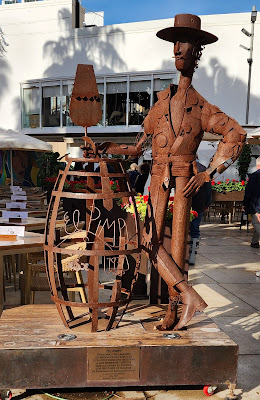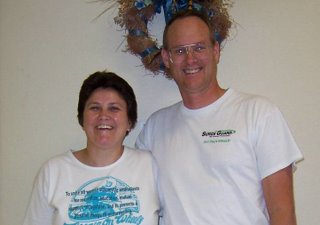 |
| Moon set over Malaga at 7:07 am. |
 |
| By the time we had breakfast, the sky was beginning to lighten. |
 |
| Here we are docking and can see the movable walkways we will use to get off the ship. |
 |
| Looking toward town from the aft deck pool area. |
 |
| Here comes the sun. |
 |
| You can see Malaga is built up the hillside. |
 |
| Hotel Miramar. Looks too expensive for me. |
 |
| Cool apartment building right across the street from the beach. |
 |
| There were lots of interesting looking buildings and homes along the beachfront. |
 |
| We left the beach and started winding up the hillside. I was checking out some of the homes as we went. |
 |
| The tour guide mentioned how, in times of great rainfall, these ravines could pour a lot of water down the hillsides. |
 |
| If your lot isn't big enough, you can always cantilever you home out over the hillside. |
 |
| Our bus parked in this area by Gibralfaro Castle. We didn't tour the Castle, but instead, we walked to the Gibralfaro Viewpoint for a look over the town. |
 |
| Looking to the east we could see as far as the Torre Vigía Las Palomas (Las Palomas Watchtower). |
 |
| I wondered what all the manmade land extensions were. Looks like they are small boat harbors. |
 |
| Looking straight out from the viewpoint, we can see our cruise ship. |
 |
| Next we walked down the road to a hotel on the hilltop. There was another panoramic viewpoint there. |
 |
| Interesting way to trim the tree. |
 |
| We stopped at Market Square to be introduced to this sculpture of Picasso that was placed in 2008. Why Picasso? Well he was born on October 25th of 1881 in Malaga at #15 of this square. |
 |
| Other side of the monument. Our guide told us that there is a chance the bodies are no longer buried beneath the monument. Who knows. |
 |
| Our tour continued down a narrow street to La Parroquia Santiago Apóstol Málaga. |
 |
| Begun in 1509, this still-operating Catholic church displays Islamic, gothic & baroque elements. |
 |
| Tree decorated with lights for Christmas. |
 |
| This 1st century theatre sits just below the Alcazaba and was built over Roman baths. It was abandoned in the 3rd century. |
 |
| A platform has been added so the theatre can be used for entertainment. |
 |
| This glass pyramid was built over some ruins of the fish salting business that used the theatre area in the fifth century. |
 |
| El Pimpi advertisement outside the restaurant that is located in an area where Antonio Banderas has an apartment. He was born and made his acting debut in Malaga. |
 |
| The sole tower of the Santa Iglesia Catedral Basílica de la Encarnación de Málaga (Holy Church Cathedral Basilica of the Incarnation of Malaga) |
 |
| Two people were dancing in Calle Echegaray |
 |
| Calle San Jose |
 |
| Church of St. Augustine |
 |
| Side entrance and gardens to the Santa Iglesia Catedral Basílica de la Encarnación de Málaga. Construction began in 1528. |
 |
| Around the corner from the Iglesia Capitular de El Sagrario, come to the front of Santa Iglesia Catedral Basílica de la Encarnación de Málaga |
 |
| The lack of a roof resulted in serious deterioration inside the cathedral temple by the year 2000. Roof work was done in 2009 but it was ineffective in keeping out the rain. In November of 2016 the powers that be pronounced themselves in favor of the completion of the cathedral according to the existing construction plans. That means they will not only construct a roof, but complete the balustrade, the tower and the sculptural program, as well as a possible expansion of the sacristy that would destroy part of the cathedral gardens. |
 |
| There's a fountain in the plaza in front of the Basilica. |
 |
| This pigeon is hoping some of the tourists drop something he can eat. |
 |
| Look at the stonework on Calle Fresca. |
 |
| Calle Marques de Larios decorated for Christmas. |
 |
| Interesting Christmas decoration. |
 |
| Back on the tour bus and headed to the ship, we rode along Paseo del Parque, or Park Street. Notice all the colorful kybos? |
 |
| Lush foliage in the park. |
 |
| "The Cube" artwork on way to port. |
 |
| Goodbye Malaga. |




































No comments:
Post a Comment